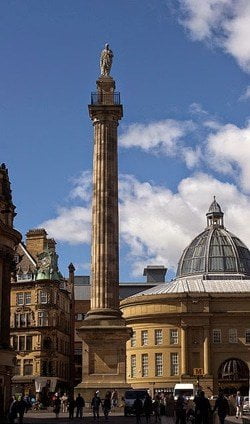Your basket is currently empty!
Grey’s Monument
Discover more about Grey’s Monument, Earl Grey and the tea

Grey’s Monument in Newcastle was built in 1838 and celebrates the passing of the Great Reform Bill by Charles, second Earl Grey, Prime Minister, in 1832. He had the famous tea named in his honour. Today, Earl Grey tea is the most famous blend but who was the man and how did the tea come about? Earl Grey was not, surprisingly for some, in the tea business. He was born at the family seat of Falloden in Northumberland. Becoming MP for Northumberland at the age of 22 he became British Prime Minister between 1830 and 1834 and was famous for passing the Great Reform Bill. This started the process of electoral reform culminating in universal suffrage and other measures such as an end to the employment of children and to slavery within the British Empire.
The acclaimed tea was created by his tea merchant in Newcastle upon Tyne close to his home at Howick in Northumberland. It is thought that it was flavoured with oil of bergamot, giving it its distinctive taste, to offset mineral lime present in the well on his estate. Earl Grey tea blend is now widespread but it was not registered as a trademark so the family never received royalties and all tea merchants are free to produce a blend of that name themselves. Some are closer to the original blend than others!
After stepping down as Prime Minister, Earl Grey left political life concentrating on his family. He had sixteen children with his wife Mary Elizabeth Ponsonby, daughter of William, Baron Ponsonby. She was Catholic from the Irish branch of her family and helped strengthen his resolve to grant emancipation for Catholics in Britain.
Grey’s Monument in Newcastle upon Tyne (pictured) honours the passing of the Great Reform Act by Charles, 2nd Earl Grey in 1832 whilst he was prime Minister. His statue was designed by Edward Hodges Baily who later designed Nelson’s statue in Trafalgar Square, London. At 135 feet high and 164 steps to the top, Grey’s Monument was erected in 1838 and is situated on Grey Street. This was voted Best Street in the UK by BBC Radio 4 listeners in 2010. It has wonderful views of Granger Town.
Back to his tea, recent research has indicated that oil of bergamot, from the Italian citrus fruit, which provides the characteristic flavouring for the Earl Grey tea blend, has its own health benefits. It is said to be better than statins at reducing cholesterol and thus protecting the cardio-vascular system from heart disease.
Today Earl Grey tea commonly uses synthetic or nature-identical oil of bergamot. Our loose leaf blend uses natural oil which gives a more balanced flavour but a shorter shelf-life so it needs to be consumed within a few months. Many blends are based upon fairly robust, medium bodied teas containing Ceylon, Assam and often East African teas. Ours is a traditional, light blend containing more expensive China black keemun and Darjeeling teas. Consequently it should be drunk without milk. Sometimes tea merchants will add little blue cornflowers to their Earl Grey. This is purely for appearance and does not change the flavour of the infusion. Ours goes without.
Some blends contain lapsang souchong for a smoky character. Ours does not but this tea does feature in our Good Afternoon! Blend. We also produce a Green Earl Grey based upon China green tea. This is becoming increasingly popular and has recognised health benefits. It suits the bergamot flavouring well, being light and fresh. Just remember, as with all green teas, to use fresh water that has come off the boil and cooled to around 80 degrees C. This will ensure that any bitterness is avoided.
We only offer large leaf teas, OP grade and above. We do not sell teabags which contain very small tea particles. Making your Earl Grey from a larger leaf grade means you get a better, more balanced flavour. Whilst requiring a little longer to infuse, the tea has time to release all flavour components of the tea without excessive tannins. It is these highly soluble tannins that infuse quickly from small leaf grades and would create an excessively tannic brew if given the same time to infuse as a large leaf tea.
Finally, as my name is Richard Grey, the founder of Grey’s Teas, you might want to know whether I have a link with Charles 2nd Earl Grey after whom the tea was named. The answer is that he is my four-times great uncle. So I am descended from his father, the 1st Earl Grey. Name is one thing. We endeavour to offer the world’s greatest teas!
See our Earl Grey tea blend
